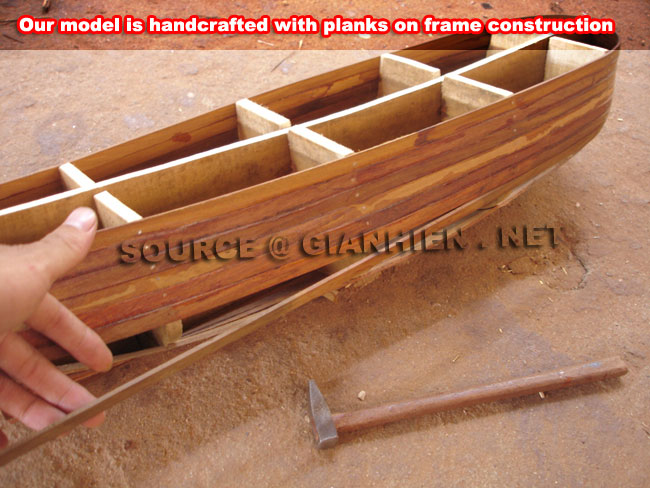|
HISTORY
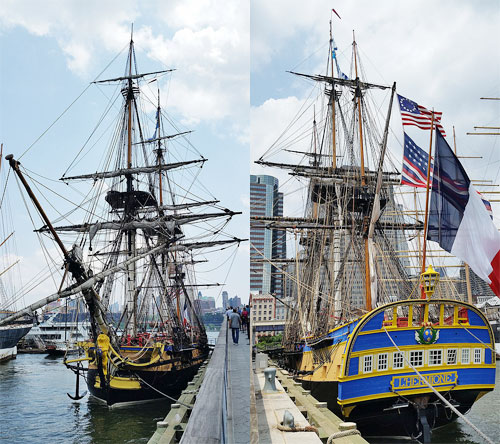 The
Hermione is a 12-pounder Concorde class frigate, completed in
Rochefort by the Asselin organisation in 2014. She is a
reproduction of the 1779 Hermione, which achieved fame by
ferrying General Lafayette to the United States in 1780 to allow
him to rejoin the American side in the American Revolutionary
War. The
Hermione is a 12-pounder Concorde class frigate, completed in
Rochefort by the Asselin organisation in 2014. She is a
reproduction of the 1779 Hermione, which achieved fame by
ferrying General Lafayette to the United States in 1780 to allow
him to rejoin the American side in the American Revolutionary
War.
Construction
This project was conceived by members of the Centre
International de la Mer in 1992, and construction began in 1997,
envisaging a launch in April 2015 (as compared to the original,
which took less than a year to build).
The shipyard was in one of the two dry docks beside the Corderie
Royale at Rochefort.
As far as possible, traditional construction methods were used
although modern power tools were substituted for the period
tools on some jobs. The site is open to the public, and
admission fees help fund the project.
English plans of a sister ship, Concorde, were used. The cost
was estimated to be $22 million. The original plans had been
modified in several ways for reasons of strength and safety:
planks had been bolted rather than pegged to avoid movement
during the long period of construction. Similarly, the mast
sections were fastened with glue rather than metal hoops to
avoid water penetration. The cannons are lightweight and
non-functional to save weight, and for safety reasons. Hemp
rigging was used, and the sails made of linen.
An engine will be used for safety, and electric generators for
lighting and basic amenities.
2015 voyage
In preparation for a transatlantic voyage in 2015, the frigate
departed from Rochefort and started her sea-worthiness trials on
7 September 2014.
In April 2015, Hermione started her return voyage to the United
States. Hermione’s itinerary is meant to reaffirm the
relationship between the United States and France.
More
history of this ship...
In 1776 relations
between Great Britain and the partisans for independence from
the colonies of North America are tarnished. The Marquis de La
Fayette upon his return to France from America endeavours to
obtain France's support to the conflict. The Marquis de La
Fayette conviced Louis XVI to give his backing. In 1780, La
Fayette embarked on the Hermione to fight alongside the American
insurgents for independence.
Marie Joseph Paul Yves Roch
Gilbert du Motier, Marquis de La Fayette once said that he loved
liberty “with the enthusiasm of religion, the rapture of love,
and the conviction of geometry.” In pursuit of this passion, he
dedicated his life to the creation of democracy in America and
France. Revered by many in both the new world and the old, La
Fayette became known as the “Hero of Two Worlds.”
Born in Auvergne, France, La Fayette’s ambition was to follow in
his father’s footsteps and become an officer. He joined the
French army at the age of 16. Like many of his countrymen, he
developed an abiding enthusiasm for the ideal put forth in
America’s Declaration of Independence. He invested his own funds
and outfitted a frigate, sailing for America in 1777, where he
joined the forces of General George Washington, with whom he
established a lifelong friendship.
In 1779, the Marquis de La Fayette traveled back to France for
the birth of his son, whom he named George Washington du Motier.
In March of 1780, he sailed from Rochefort, France on the
frigate L’Hermione, arriving in Boston in April.
In 1781, the Battle of Yorktown, Virginia was a victory by the
combined American and French force led by General George
Washington, the Marquis de La Fayette, and the Comte de
Rochambeau over the British army commanded by General Lord
Charles Cornwallis. The surrender of Cornwallis’ army caused the
British government to negotiate an end to the American
Revolutionary War.
In 2007, France and the United States will salute La Fayette’s
achievements with a celebration of the 250th anniversary of his
birth. A variety of events and activities will hail La Fayette’s
contributions to democracy and promote positive relations
between the United States and France.
Hermione official website
http://www.hermione.com
***
Sept. 20, 2007
Cornellian Peggy Mamet and crew visit Lafayette's ship
By Linda Myers
ROCHEFORT, France -- Aug. 5
turns out to be the hottest day of the year in this river port
linked to the Atlantic Ocean in France's Charente-Maritime
region, but Cornell alumna Margaret (Peggy) Bratley Mamet, Class
of '59, and her family don't let it deter their tour of
L'Hermione, the life-size replica of the Marquis de Lafayette's
(1757-1834) 18th-century fighting frigate.
A team of about a dozen workers is painstakingly constructing
the ship in a plan to help revive Rochefort as a tourist
attraction. A bustling shipbuilding center when ships had sails,
the city declined after France closed its arsenal here in the
1920s, and much of its port was destroyed by Nazi Germany during
World War II.
Mamet and her husband, Bernard, have traveled about 110 miles
from their home in the Vienne River Valley near Chinon for a
guided tour of the ship's progress. It is their third such
visit. The air is heavy with the smells of sun-baked woodchips
and tar. Donning yellow hardhats, the group, which includes
several more family members and about a dozen others, gamely
descends a rudimentary staircase leading to the interior of the
ship's hull. It is cooler below but also darker, almost
otherworldly, with supporting beams of wood resembling the
vertebrae and ribs of a whale.
When finished in about 2011, the 145-foot, three-masted,
32-gunned sailing ship will follow in the wake of Lafayette's
1780 voyage aboard the first L'Hermione to Boston to inform Gen.
George Washington's army that France would be sending more ships
and soldiers to support their revolutionary war against the
British. "France was anti-English and wanted revenge for past
attacks," explains Bernard Mamet.
The estimated cost of the replica is about $22 million. Unlike
the original Hermione, which Louis XVI paid for, this ship
depends mostly on private donations, which have been slow in
coming. But The New York Times recently ran a feature story
about the ship and its most illustrious passenger, Lafayette,
whom it dubbed "the founding father of French-American
friendship."
Now the project is beginning to attract interest outside France,
and hopefully, donations will follow, says a buoyant Peggy
Mamet. She joined the Hermione-Lafayette Association soon after
retiring to central France in 1999, after a career in the
sciences at the University of Montreal.
"I thought the project was very interesting," she reports. "I
told them I wanted to be on the boat here in Rochefort and then
be in Boston to greet it."
To replicate the frigate exactly, the team involved in the
project looked at the remains of the actual Hermione, which sank
off the coast of Brittany in 1793 and was recovered in 1992, the
ship's log books and blueprints of a sister ship, drawn by
Britain's Royal Navy after that ship's capture.
Lafayette was not the captain of L'Hermione, explains the Aug. 5
tour guide in French. Rather he was a privileged passenger who
wined and dined with the captain and officers during the 38-day
voyage. The crew, apparently, had to content themselves with
sea-weevil-infested biscuits.
According to the online guide to the Lafayette Collection in
Cornell Library's Division of Rare and Manuscript Collections,
the Marquis de Lafayette, a young French aristocrat from the
rural Auvergne region, made his first trip to the American
colonies in 1777 in another ship, La Victoire, in hopes of
gaining the king's favor for his exploits. He served in the
Continental Army, was wounded in the battle of Brandywine and
survived the winter at Valley Forge alongside Washington.
Initially viewed as a hero in France when he returned, he
advocated for the rights of man early in the French Revolution.
But his sympathy toward the king and later support for the
monarchy brought criticism from ordinary Parisians.
"While Lafayette was not a major figure in French history, he is
certainly important to Americans," comments Peggy Mamet. "He
played a particular role in U.S. history and led the French to
support the American cause."
She plans to return to campus for her 50th reunion in June 2009
and hopes to spread the word among her classmates and others
about L'Hermione. "I want to let Americans know about this huge
French initiative and that it would be wonderful if they can
help financially, be involved and be there to welcome it," she
says. After its maiden voyage to Boston, L'Hermione II will sail
back to Rochefort and remain there as a tourist attraction.
Freelancer Linda Myers is a former writer for the Cornell
Chronicle.
***
L'HERMIONE À ROCHEFORT :
LA FRÉGATE de Monsieur " LA FAYETTE "
La Frégate " La Fayette " Bâtiment nouvelle génération de la
Marine Française
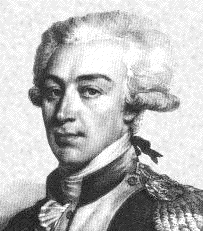
Qui était LA FAYETTE ?
Né le 6 septembre 1757 à Chavaniac (Haute-Loire ), Marie-Joseph,
Paul, yves, roch, Gilbert du Motier, Marquis de La Fayette,
connaît la jeunesse dorée d'un riche aristocrate. Il épouse le
I11avril 1774, marie-adrienne, Françoise de Noailles, fille du
duc d'Ayen .
Acquis aux thèses de la révolution américaine depuis le fameux
dîner de Metz chez le comte de Broglie, il embarque le 26 avril
1777, en semi-clandestinité, sur " LA VICTOIRE " pour venir en
aide aux "Insurgents".
Nommé major général de l'armée des Etats-Unis, il participe à la
guerre d'Indépendance, est blessé à Brandwine et combat à la
tête des troupes de Virginie avant de renter à Brest, à bord de
" L'ALLIANCE ", en janvier 1779.
A son retour, il soutient l'envoi outre-atlantique d'un corps
expéditionnaire commandé par Rochambeau. Il embarque à nouveau
vers l'Amérique sur " L'HERMIONE " commandée par
Latouche-Tréville, et participe à Ici bataille de Yorktown
(octobre 1781) qui scelle la fin de la colonisation anglaise.
De retour à Lorient en janvier 1782, il repart pour un troisième
voyage américain, en juin 1784, à bord du " COURRIER DE NEW YORK
". Au terme de sa tournée, il rentre en France à bord de " LA
NYMPHE ", héros des Deux-Mondes auréolé de gloire.
Mais le rêve américain se dissipe pour laisser rapidement place
aux troubles annonciateur de la tourmente révolutionnaire.
Ami de Neker et de Mirabeau, franc-maçon épris d' idées
nouvelles, ce digne fils des Lumières est élu en mars 1789
député de la noblesse aux Etats généraux et propose au mois de
juillet 1789 une déclaration européenne des droits de l'homme et
des citoyens. Nommé par acclamation commandant général de la
milice parisienne, noyau de la future garde Nationale, il fait
adopter la cocarde tricolore comme insigne de ce corps.
Idéaliste, il échoue dans sa tentative de concilier la royauté
et le révolution. En octobre 1791, il abandonne ses fonctions à
la tête de la Garde Nationale pour prendre le commandement de
l'armée du Centre. Il assiste, impuissant, à l'effondrement de
la monarchie.
Peu après la création du Tribunal révolutionnaire (17 août 1792)
La Fayette, mis en accusation, s'enfuit ; il est arrêté le 25
août 1792 à Nivelle par les Autrichiens qui l'internent à
Magdebourg, puis à Olmütz.
Libéré en septembre 1797, il rentre en France en novembre 1799
et s'installe au château de La Grange.
Rayé de la liste des Émigrés (1800 ), il refuse tout poste
officiel et se consacre à l'agriculture ainsi qu'à la rédaction
de ces mémoires. Sa retraite est assombrie en 1807 par le mort
de sa femme, marie-adrienne.
La fin du Premier Empire l'incite à revenir sur le devant de la
scène politique ; élu député de Seine-et-Marne lors des cents
jours, il demande l'abdication de Napoléon 1er.
Député de la Sarthe en octobre 1818, puis à nouveau de Seine et
Marne en septembre 1819, il s'oppose résolument à la
Restauration et adhère à la Charbonnerie en 1821. Réélu député
en novembre 1822, à Meaux, il est battu aux élections de 1823.
Il part alors pour les Etats-Unis à bord du " CADMUS " pour une
tournée triomphale d'août 1824 à septembre 1825. Rentré en
France sur la Frégate " BRANDYWINE ", il est réélu député de
Meaux en juin 1827 et en juillet 1830 ; il connaît son ultime
heure de gloire lors des Trois Glorieuses : nommé commandant de
la Garde Nationale, il fait acclamer le duc d'Orléan, au balcon
de l'hotel de ville de Paris, après l'avoir accueilli par ces
mots : " Voici la meilleure des républiques "; néanmoins, il se
détache rapidement du nouveau régime et abandonne son
commandement de la Garde Nationale en décembre 1830. Réélu
député de Meaux en juillet 1831, il meurt le 20 mai 1834 à l'âge
de 76 ans; il est entérré au cimetière de Picpus à Paris.
Un peut d'histoire :
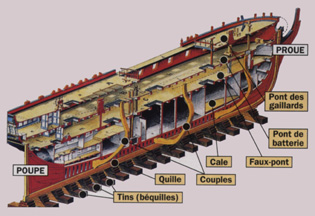 En
Charente, dans le site historique de la Corderie royale, un
navire de légende renaît sous vos yeux. En
Charente, dans le site historique de la Corderie royale, un
navire de légende renaît sous vos yeux.
Louis XIV avait choisi Rochefort pour y bâtir son arsenal le
plus prestigieux.
Aujourd'hui, une équipe de passionnés y reconstruit l'Hermione,
la frégate de La Fayette
En 1780, ce fougueux amiral de 22 ans s'embarquait pour
l'Amérique. Il rejoignait les insurgés américains pour les aider
à conquérir leur indépendance.
Le trois-mâts actuel est reconstruit selon les plans de
l'époque.
En 2007, I'Hermione refera le trajet de La Fayette en navigant
jusqu'à Boston.
Ce chantier public est situé à deux pas de la Corderie Royale,
un magnifique bâtiment de facture classique où l'on fabriquait
les cordages des navires de guerre. Durant la Seconde Guerre
mondiale, il fut occupé par les Allemands qui l'incendièrent en
partant.
Le site se transforme alors en un champ de ruines envahi par les
ronces.
Dans les années 70, un amiral, qui loge non loin, se désole de
cet abandon et lance le coup d'envoi de la rénovation.
Depuis, la Corderie a été restaurée à l'identique : une
merveille !
LA VISITE DU CHANTIER
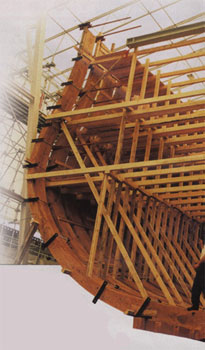 La
frégate est construite dans une forme de radoub, une immense
fosse où l'on réparait les navires à l'époque de Louis XIV.
Grâce aux passerelles, vous longez tout le bateau dans lequel
travaillent 6 charpentiers. L'ossature de la coque est formée de
couples, des doubles poutres taillées dans des chênes tordus
(ayant une courbure naturelle). La
frégate est construite dans une forme de radoub, une immense
fosse où l'on réparait les navires à l'époque de Louis XIV.
Grâce aux passerelles, vous longez tout le bateau dans lequel
travaillent 6 charpentiers. L'ossature de la coque est formée de
couples, des doubles poutres taillées dans des chênes tordus
(ayant une courbure naturelle).
Regardez attentivement le panneau suspendu qui montre le navire
en coupe : le pont supérieur était peint en rouge pour que la
vision des blessés perdant leur sang soit moins effrayant pour
leurs camarades en train de combattre !
Juste avant l'immense tente qui abrite le navire, vous pourrez
admirer 2 ateliers où 5 artisans (3 forgerons et 2 ébénistes)
fabriquent des pièces pour le trois-mats.
Dans l'ébénisterie, on rassemble actuellement des affûts de
canon en chêne.
la Corderie royale
Ses dimensions (372 m, pour 8 m de largeur) correspondent à la
taille des cordages de l'époque (une encablure). Mise en service
en 1670 la Corderie est une prouesse architecturale : le site
étant marécageux, 14 000 m3 de chêne stabilisent les fondations
! Admirer les contreforts en volute, qui empêchent le bâtiment
de bougerŠ. Une grande salle présente l'histoire de l'Arsenal,
les outils, les cordages. On accède ensuite à une exposition sur
un thème maritime.
|

